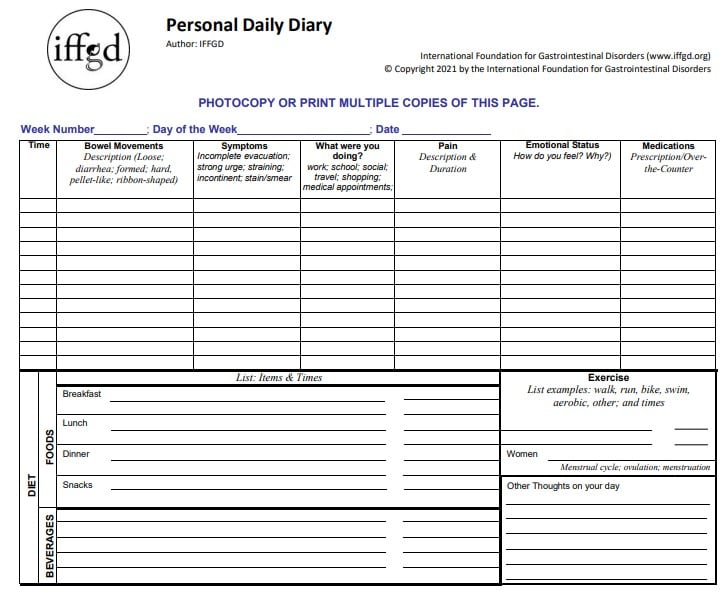Chronic or recurring diarrhea (loose, watery, or frequent stools) can occur in many different digestive disorders. If you have more than mild, short-term diarrhea, you should consult a physician to obtain a diagnosis and receive specific treatment.
In some people, chronic diarrhea may be controlled to some extent through changes in diet and lifestyle. The good news is that making some changes to what, when, and how much a person eats and drinks, along with medications, if indicated can improve the quality of life for some.
All of the suggestions listed in this article may not work for everyone. It is important to consult with your doctor or dietitian before making decisions about your treatment.
Role of the BRAT Diet
If have experienced chronic diarrhea, you have probably been advised to try the BRAT diet. This stands for: Banana, Rice, Applesauce, Toast.
These foods slow down the intestines and decrease how often you have bowel movements. The BRAT Diet is not very nutritious and should not be used for a long period of time.
As a starting point, here are some extreme diet changes that are not recommended:
- Do not avoid all fiber,
- Do not limit your diet to only liquids,
- Do not cut out all liquids (you can become dehydrated), and
- Do not exclude foods with sodium and potassium. These are important electrolytes that can become low when you have diarrhea.
What Diet Changes May Help
If you have chronic diarrhea, it is a good idea to keep a food diary. This can help you identify problem foods, difficult times of the day, and symptoms. You should share your food symptom diary with your healthcare provider or dietitian. This will help them see if there are any foods causing your symptoms.

Foods that May Lead to or Worsen Diarrhea in Sensitive Individuals
- Milk and other dairy products
- Legumes (chickpeas, beans, peas, lentils and lupins) and cabbage family vegetables—these are all high in fiber
- Fruits and juices that contain fructose
- Caffeine-containing beverages such as coffee and tea
- Alcoholic beverages such as beer, wine, and liquor
- Fatty meats such as bacon and heavily marbled meats
- High fat foods such as fried foods, pastries, and chips
- Artificial sweeteners such as NutraSweet®, Splenda®, Equal®, sorbitol, etc.
- Sugar-free gums and mints that contain sorbitol, mannitol, or xylitol
- Real black licorice (not the candy)
- Large quantities of nuts or nut butters
- Concentrated sweets
o Dried fruits such as figs, dates, raisins, and prunes
o Prune juice
Foods/Fluids that may Improve Diarrhea
- Increase fluids to prevent dehydration. Try to drink these fluids between your meals. Liquids with a meal may speed up stomach emptying and
possibly worsen diarrhea. - Eat and/or drink foods and beverages with sodium
 and potassium. Diarrhea can lead to low levels of both sodium and potassium, so it is important to replace these electrolytes through your diet
and potassium. Diarrhea can lead to low levels of both sodium and potassium, so it is important to replace these electrolytes through your diet
- Broth (sodium)
- Sports drinks (sodium and potassium); however, avoid sugar-free drinks which have artificial sweeteners (see list above)
- Equalyte®, Pedialyte® (sodium and potassium)
- Bananas (potassium)
- Nectars (potassium)
- Boiled or mashed potatoes (potassium)
- Eat lower fiber foods:
- Yogurt (if you are lactose intolerant, may want to avoid)
- Rice
- Noodles
- White bread
- Cream of wheat
- Smooth peanut butter, a small amount at a time
- Lean meats
- Drink beverages at room temperature, not too cold or hot
Supplements that May Help to Control Diarrhea
Probiotics may help prevent antibiotic-associated diarrhea. They are found in yogurts that contain Live Active Cultures (LAC) such as lactobacillus acidophilus. Look for the term LAC on the label of yogurts in the dairy aisle (note: frozen yogurt does not contain LAC).
Pectin is a form of fiber found in fruits and some vegetables that may slow the movement of stool in your intestines. It is also sold as a powder in grocery stores. You can find this in the aisle with pudding and gelatin. To help with diarrhea, mix 1 tablespoon of pectin powder with ¼ cup of lemon water and drink it 20–30 minutes before a meal.
The Bottom Line
To prevent complications that can result from frequent bowel movements, do try to do the following:
- Keep a food and symptom diary to help identify which foods, drinks, and supplements may be leading to or worsening your diarrhea
- Eat smaller, more frequent meals during the day
- Sit and relax for 20-30 minutes after you eat
- Drink plenty of fluids in between your meals
- Eat and drink foods and beverages that contain sodium and potassium
Remember, generalized dietary advice does not work for everyone. The influence of diet is unique to each individual. If you have questions about your symptoms and circumstances, talk to your healthcare provider. They will be able to identify dietary and other changes that may decrease your symptoms and improve your quality of life.
IFFGD’s Dietitian Listing is a resource that allows you to search for a dietitian that is in your area or treats a specific condition.
Are you also struggling from IBS-D? Learn more about IBS and Your Gut
Adapted from IFFGD Publication #208- Diet Strategies for Managing Chronic Diarrhea By: Leslie Bonci, M.P.H., R.D., L.D.N., C.S.S.D., Director, Sports Nutrition, University of Pittsburgh Medical Center, Pittsburgh, PA Updated by: Christopher Almario, MD Cedars-Sinai Medical Center in Los Angeles, California, USA Edited by: Shanti Eswaran , MD Associate Professor, Internal Medicine, Division of Gastroenterology, University of Michigan, Ann Arbor, MI

 and potassium. Diarrhea can lead to low levels of both sodium and potassium, so it is important to replace these electrolytes through your diet
and potassium. Diarrhea can lead to low levels of both sodium and potassium, so it is important to replace these electrolytes through your diet













